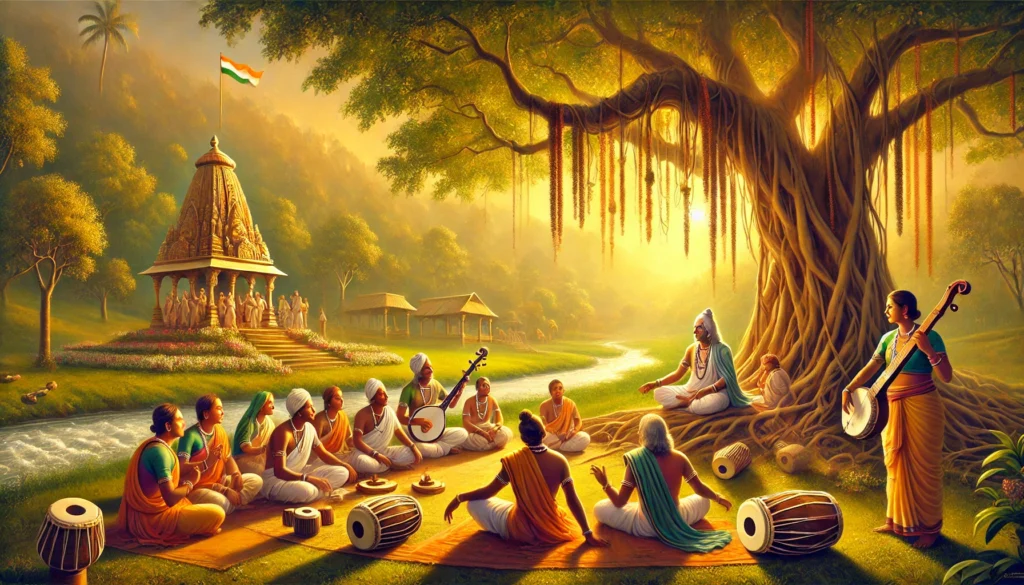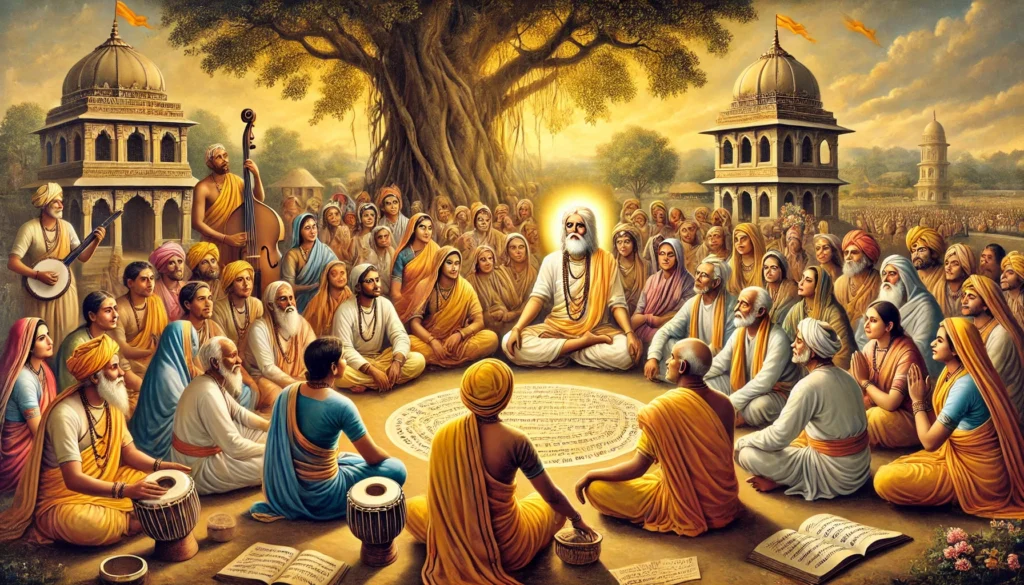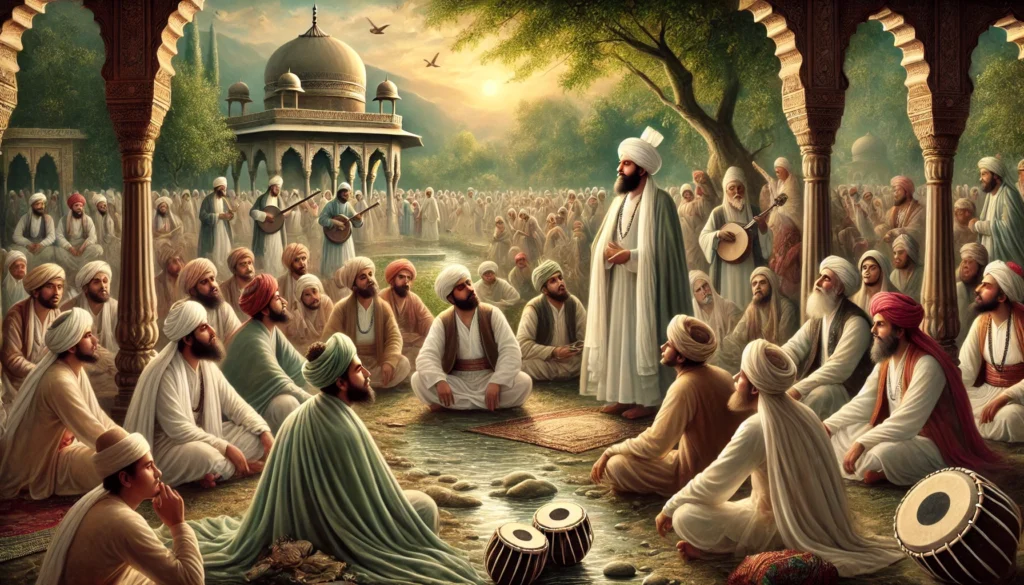
The Bhakti movement was a major religious and social movement in India between the 7th and 17th centuries , which brought a message of new energy and equality in Hinduism. This movement started mainly from South India and gradually spread to North India. Its aim was to make devotion to God simple and accessible to all by challenging the complex rituals and brahminical dominance of the religion.
features:
- Emphasis on devotion to God : The movement gave importance to single-minded devotion to God instead of idol worship , sacrifices and rituals.
- Message of equality : Rising above caste , religion , gender and social class, everyone was declared to have the right to worship God.
- Simple form of language : Saints wrote their compositions in local languages so that the common people could understand it.
- Example: Tulsidas (Awadhi) , Kabir (Sadhukari) , Meerabai (Rajasthani).
- Social reform : Raised voice against superstition , casteism and discrimination.
- Glory of Guru : Guru is considered to be the medium of spiritual knowledge.
Prominent saints:
- North India : Kabir , Surdas , Tulsidas , Mirabai , Rahim.
- South India : Alvars , Nayanars , Basavanna.
Contribution:
- Promoted social equality and religious tolerance.
- Contributed to the development of Indian languages and literature.
Sufi Movement
The Sufi movement emerged as a mystical movement within Islam during the 8th to 17th centuries. This movement was primarily based on the spirituality of Islam and aimed to establish a personal and loving relationship with God.
features:
- Message of love and service : Sufi saints gave priority to service to humanity and love for God.
- Opposition to rationalism and rigidity : Gave importance to Sufi meditation and love instead of the strict rules of Sharia.
- Social equality : Rising above caste , class and religion, humanity was considered supreme.
- Use of music and poetry : Qawwali and Sufi songs were used to express spirituality.
- Khanqah and Dargah : The residences (khanqah) and mausoleums (dargah) of Sufi saints grew in importance , and remain centres of communal harmony even today.
Major Silsilas (Sufi orders):
- Chishti Silsila : Khwaja Moinuddin Chishti (Ajmer).
- Suhrawardi Silsila : Sheikh Bahauddin Zakariya.
- Naqshbandi series : Khwaja Bahauddin Naqshbandi.
- Qadiri Silsila : Shaikh Abdul Qadir Jilani.
Contribution:
- Promoted cultural and religious coordination between Hindu and Muslim society.
- Preached love , service and tolerance.
- Qawwali and Sufi literature enriched art and culture.
Similarities between Bhakti and Sufi Movements:
- Emphasis on spirituality : Both movements stressed on inner devotion and love rather than external rituals.
- Social equality : Opposed caste , religion and class discrimination.
- Use of local languages : Used local languages to convey the message to the common people.
- Music and Poetry : Both used music and poetry to express their message.
Effect:
- Social reform : Caste system and religious fanaticism declined.
- Communal Harmony : Both the movements created an atmosphere of better understanding and peace between Hindu and Muslim society.
- Development of Literature and Art : Bhakti and Sufi literature enriched Indian literature and music.
These movements left a lasting impact on Indian society and promoted the message of religious tolerance , humanity and love.
Bhakti movement

Bhakti movement It was a major religious and social reform movement of medieval India , which developed mainly between the 7th and 17th centuries. The aim of this movement was to make devotion to God simple , personal and universal by freeing religion from rituals , dogmatism and brahmanical domination.
Emergence of Bhakti Movement
The Bhakti movement has its roots in South India , where Alvars (Vaishnavite saints) And Nayanar (Saivite saint) Such saints propagated a religious ideology based on devotion. This movement later spread to North India and here it was carried forward by saint poets , Sufis and other devotional saints.
Main features of Bhakti movement:
- Sincere devotion to God :
- The Bhakti movement considered love and devotion towards God as supreme.
- God was worshipped in a personal form , whether nirguna (Brahma) or saguna (Rama , Krishna etc.).
- Opposition to caste and class discrimination :
- Bhakti saints strongly criticized the caste system and said that caste is not a bar to devotion to God.
- ” No one cares about caste or creed , if one worships Hari, it belongs to Hari.” (Kabir)
- Secularism and equality :
- This movement looked at all religions with equal vision and supported social equality.
- Hindu and Muslim saints participated equally.
- Language and Literature :
- Bhakti saints used regional languages (Awadhi , Braj , Tamil , Marathi , Punjabi, etc. ) instead of Sanskrit so that the common people could easily understand these teachings.
- The result was that the literature of regional languages became rich.
- Opposition to rituals and brahminical dominance :
- challenged religious practices based on ritualism , idol worship and yajna.
- The saints said that to attain God only devotion from the heart is required.
- Glory of the Guru :
- Guru was considered the medium of guidance of devotion.
- ” Guru and Govind both are standing , whose feet should I touch. I am grateful to my Guru , who showed me Govind.” (Kabir)
Major saints of Bhakti movement and their contributions:
South India:
- Alvars and Nayanars :
- Alvars (Vaishnavite saints) and Nayanars (Shaivite saints) composed devotional literature in the Tamil language.
- His works such as divine management And Tevaram Are famous.
- Basavanna :
- He founded the Veerashaiva or Lingayat sect and opposed the Brahminical order.
North India:
- Kabir ( 1440-1518) :
- The main saint of Nirgun Bhakti.
- He gave the message of Hindu-Muslim unity.
- His works invoice are compiled in.
- Mirabai ( 1498-1547) :
- Symbol of devotion to Krishna and the leading saint of Sagun Bhakti.
- His poems are famous in Braj and Rajasthani languages.
- Tulsidas ( 1532-1623) :
- The biggest promoter of Ram Bhakti.
- his main work Ramcharitmanas Which is written in Awadhi .
- Surdas ( 1478-1583) :
- The saint who describes the childhood pranks of Krishna.
- His major work Sursagar Is.
Maharashtra:
- Dnyaneshwar ( 1275-1296) :
- Dnyaneshwari Wrote the work named in Marathi language.
- Tukaram ( 1608-1649) :
- Composed devotional songs in the Abhang style.
Punjab:
- Guru Nanak ( 1469-1539) :
- Founder of Sikhism and preacher of Nirguna Bhakti.
- His teachings Guru Granth Sahib are compiled in.
Effects of Bhakti Movement:
- social reform :
- Attacked social evils like casteism and untouchability.
- Provided the right to equality to all classes.
- religious tolerance :
- Encouraged Hindu-Muslim unity.
- Opposed religious fanaticism.
- Development of Indian languages :
- The works of the saints enriched the regional languages.
- Strengthened the tradition of literature and music.
- Women Empowerment :
- Saint women like Mirabai tried to improve the condition of women in the society.
- Cultural coordination :
- The Bhakti and Sufi movements together paved the way for cultural and religious synthesis in India.
conclusion:
deeply influenced Indian society from a religious , social and cultural point of view. It envisioned a society that was beyond the boundaries of caste, class and religion through the message of love, service, tolerance and equality . The influence of the Bhakti movement can still be seen in Indian society and culture today.
Sufi Movement

Sufi Movement A mystical and spiritual movement within Islam that emerged in the 8th century and exerted significant influence in India from the 12th to the 17th centuries. Sufi saints went beyond the rigid religious rules of Islam (Sharia) and emphasized love , service , and inner devotion to God. This movement was a symbol of not only religious but also social reforms.
Origin and Development of the Sufi Movement
- Origin :
- The Sufi movement originated in the Islamic world of Arabia.
- ” Sufi” means “wool” (Arabic: Suf ), which symbolizes the simple woolen garments that Sufi saints wore.
- Development :
- The Sufi tradition developed the spiritual and mystical aspect of Islam.
- It prioritized love for God and spiritual experiences , while departing from the Sharia and rigid religious rituals of Islam.
- Arrival in India :
- The Sufi tradition spread in India with the Muslim invasions in the 12th century and the arrival of Sufi saints.
- It ran parallel to the Hindu Bhakti movement and had a profound impact on Indian society.
Main features of the Sufi movement
- Principle of love and service :
- Sufi saints considered God as the symbol of love and said that attainment of God is possible through love and service.
- ” The love of God is the only true religion.”
- social equality :
- Sufi saints rejected discrimination on the basis of caste , religion and social classes.
- He believed that God is equal for all.
- Opposition of rationality and rigour :
- Emphasis on Sufi meditation and spirituality rather than the rigid rules of Sharia (Islamic law).
- Personal experience was considered more important than religion.
- Music and Qawwali :
- Music and Qawwali were used to express the glory of God and spirituality.
- The tradition of Qawwali is still prevalent in Sufi shrines.
- Khanqah and Dargah :
- The residences (khanqahs) and tombs (dargahs) of Sufi saints became centres of social and religious tolerance.
- Role of Spiritual Guru :
- In the Sufi tradition, the guidance of the Guru (Pir) is extremely important.
- The disciple (murid) tries to get closer to God through the teachings of the master.
Sufi Orders (Silsilas)
There were several major silsilas of the Sufi movement in India , which had a profound impact on society:
- Chishti Silsila :
- The most famous Sufi order of India.
- Founder: Khwaja Moinuddin Chishti (Ajmer).
- This series was based on the message of love , service and humanity.
- Suhrawardy series :
- Founder: Sheikh Bahauddin Zakaria.
- This sect emphasized spirituality while following the external rules of Islam (Sharia).
- Qadiri series :
- Founder: Shaikh Abdul Qadir Jilani.
- simple living , meditation and devotion to God.
- Naqshbandi series :
- Founder: Khwaja Bahauddin Naqshbandi.
- This tradition emphasized strict adherence to the Sharia.
Major Sufi Saints and their Contributions
- Khwaja Moinuddin Chishti (1141-1236):
- Founder of the Chishti order and founder of Ajmer Dargah.
- ” Gharib Nawaz”.
- He promoted Hindu-Muslim unity and emphasized service to the poor.
- Baba Farid ( 1173-1265) :
- Pioneer of devotional and Sufi poetry in the Punjabi language.
- His teachings are also included in the Guru Granth Sahib.
- Hazrat Nizamuddin Auliya ( 1238-1325) :
- The chief saint of the Chishti order.
- His disciple Amir Khusro popularized Qawwali.
- Sheikh Bahauddin Zakariya ( 1182-1262) :
- The chief saint of the Suhrawardi order.
- He propagated Sufi philosophy.
- Hazrat Amir Khusro ( 1253-1325) :
- A famous Sufi poet and musician.
- Father of musical forms such as Qawwali , Khayal and Tarana.
Influence of the Sufi movement
- religious tolerance :
- The Sufi movement promoted mutual respect and understanding between Hindu and Muslim societies.
- social equality :
- Efforts were made to end caste and class distinctions.
- The poor and the backward were made to feel self-respect.
- Cultural coordination :
- Indian and Islamic cultures were coordinated.
- New styles developed in music , literature and art.
- Influence on Bhakti movement :
- The Sufi movement and the Bhakti movement mutually influenced each other.
- Both emphasized on love , service and spirituality.
- Development of Literature and Music :
- The poetry and music of Sufi saints enriched Indian literature and music.
- Qawwali and Sufi songs remain popular even today.
conclusion
The Sufi movement taught Indian society the lesson of spirituality , love and service. It challenged religious fanaticism and gave the message of tolerance and humanity. The influence of the Sufi movement can still be felt in Indian society , art and culture. Its centers (dargahs) are still symbols of communal harmony.
Similarities between Bhakti and Sufi movements
Bhakti and Sufi movements are two major movements in the religious and social history of India , which had a profound impact on the society between the 12th and 17th centuries. Both movements centered on spirituality , love , and equality and opposed religious fanaticism and rituals. These movements developed in parallel and established cultural syncretism between Hindu-Muslim society.
1. Emphasis on devotion to God
- Bhakti Movement : Bhakti saints gave the highest place to devotion to God. They worshiped God in Saguna (Ram , Krishna) and Nirguna (unmanifested Brahma) forms.
- Sufi Movement : Sufis gave priority to deep love and surrender to God (Allah). They described this love as the path of spiritual practice.
- Equality : Both said that devotion to God should be accessible to every person , irrespective of his caste , religion , or class.
2. Promotion of social equality
- Bhakti Movement : Strongly opposed casteism and social discrimination. Saints believed that caste has no importance for devotion.
- Example: Kabir said , ” No one should ask about caste or creed , if you worship Hari, you will be blessed with Hari.”
- Sufi Movement : Sufis also preached equality and gave priority to serving the poor , the weak , and the marginalized sections of society.
- Example: Khwaja Moinuddin Chishti described helping the poor and needy as the greatest religion.
- Equality : Both the movements gave equal rights of love and devotion to every section of the society.
3. Opposition to religious fanaticism and rituals
- Bhakti Movement : Opposed rituals , idol worship and brahminical dominance. Saints said that devotion is the simplest way to attain God.
- Sufi Movement : Emphasis on inner love and spirituality rather than on the rigid rules of Sharia (Islamic law) and external religious rituals.
- Similarities : Both movements tried to make religion simple and accessible.
4. Use of local languages
- Bhakti Movement : Saints wrote their compositions in regional languages (Awadhi , Braj , Tamil , Marathi) instead of Sanskrit , so that the common people could understand it.
- Tulsidas has Ramcharitmanas Written in Awadhi.
- Surdas and Kabir used Sadhukadi and Braj languages.
- Sufi movement : Sufi saints used Persian , Arabic , and Urdu as well as Indian languages (Punjabi , Sindhi).
- Baba Farid wrote his poems in Punjabi.
- Similarities : Both the movements spread spiritual messages through local languages and enriched the literature.
5. Use of music and poetry
- Bhakti Movement : Bhakti saints expressed their feelings through bhajans , kirtans and poems. Example:
- Mirabai’s hymns express deep devotion to Krishna.
- Sufi Movement : Sufis made Qawwali and Ghazal the medium of their spiritual practice and praise of God.
- Amir Khusro popularized the Qawwali style.
- Similarities : Music and poetry were used in both movements to express the feeling of love and devotion towards God.
6. Importance of Guru and Pir
- Bhakti Movement : Guru was seen as the guide of devotion. Saints believed that without Guru, attainment of knowledge and God is not possible.
- Kabir said , ” Guru and Govind both are standing , whose feet should I touch. I am grateful to you Guru who showed me Govind.”
- Sufi Movement : Sufis considered the Guru (Pir) as a spiritual guide. Pir shows the disciple (Murid) the way to reach God.
- Similarities : Both the movements gave great importance to the relationship between Guru and disciple.
7. Message of love and humanity
- Bhakti Movement : Bhakti saints considered love for God as well as service to humanity as an important part of religion. They talked about seeing God in all living beings.
- Sufi Movement : Sufi saints considered love to be the most sacred medium to reach God. They described service to humanity as service to God.
- Similarity : Both movements considered love and humanity as the basis of religious life.
8. Religious tolerance and coordination
- Bhakti Movement : Bhakti saints stressed on Hindu-Muslim unity. Sant Kabir and Guru Nanak strongly opposed religious discrimination.
- Sufi Movement : Sufis also tried to bring Hindu and Muslim society closer. Khwaja Moinuddin Chishti and Nizamuddin Auliya preached tolerance and mutual brotherhood.
- Equality : Both movements played an important role in reducing religious and communal tensions.
9. Simple life and renunciation
- Bhakti Movement : Bhakti saints emphasized on living a simple and plain life. They taught to renounce greed , attachment , and ego.
- Sufi Movement : Sufi saints lived a life of austerity and simplicity, away from material pleasures.
- Similarities : Both movements emphasized simple living and devotion to God.
conclusion
Bhakti and Sufi movements deeply influenced religion , society and culture in Indian society. Both these movements gave the message of religious tolerance , humanity and equality and inspired people to rise above caste , religion and class differences. These movements laid the foundation of love , service , and tolerance in Indian society , which is relevant even today.
Influences of Bhakti and Sufi movements
The Bhakti and Sufi movements had a profound impact on Indian society , religion , culture , and politics. Between the 12th and 17th centuries, these movements gave a new direction to society through religious tolerance , social equality , and cultural syncretism. These influences were not only significant at the time , but are relevant even today.
1. Religious tolerance and coordination
Bhakti Movement:
- Bhakti saints promoted mutual harmony and coordination between the Hindu and Muslim communities.
- Opposed caste and religious discrimination.
- Kabir , Nanak , and Dadu stressed the unity and equality of all religions.
- Example : Kabir said , ” Hindus say dear to me is Rama , Turks say dear to me is Rahmana.”
Its message was that God is one for all , even if the name is different.
- Example : Kabir said , ” Hindus say dear to me is Rama , Turks say dear to me is Rahmana.”
Sufi Movement:
- Sufi saints encouraged Hindu-Muslim cultural coordination.
- He placed love , tolerance , and brotherhood above religion.
- Sufi dargahs (such as the dargah of Khwaja Moinuddin Chishti) became centres of religious tolerance and communal harmony.
Overall impression:
- The Bhakti and Sufi movements weakened religious fanaticism and promoted pluralism.
- These movements served to bring together various religious traditions.
2. Promotion of social equality
Bhakti Movement:
- Opposed casteism and Brahminical dominance.
- Advocated equal rights for lower castes and women.
- saint ravidas He said , ” If the mind is pure then Ganga is in the pot.”
- He gave the lower sections of the society an opportunity to connect with God through devotion.
Sufi Movement:
- Sufi saints gave equal status to people of all sections of the society.
- the poor , farmers , and the marginalized people of society was given prime importance.
- Khwaja Moinuddin Chishti Said , ” Serving the poor is true worship.”
Overall impression:
- These movements encouraged an egalitarian approach in the society.
- Weakened caste , class , and gender based discrimination.
3. Opposition to religious fanaticism and rituals
Bhakti Movement:
- The saints opposed rituals , idol worship , and external pomp.
- He described simple devotion and love as the basis of religion.
- Tulsidas And surdas Like the saints described devotion as a medium to reach God directly.
Sufi Movement:
- Sufis went beyond Sharia (Islamic law) and rituals and emphasized inner meditation and love.
- Established a tradition of connecting with God through music , dance , and meditation.
- Ameer Khusro Said , ” Love is the greatest religion.”
Overall impression:
- Both movements made religion simple , accessible , and based on personal experience.
- Religious fanaticism decreased.
4. Influence on music , literature , and art
Bhakti Movement:
- The saints composed literature and devotional songs in regional languages (Awadhi , Braj , Marathi , Tamil).
- Tulsidas , Mirabai , and Surdas enriched the Bhakti literature.
- Kirtan , Bhajan , and Ramlila developed.
Sufi Movement:
- The Sufis developed the qawwali and the ghazal.
- created new styles (tarana , khayal) by combining Indian and Islamic musical traditions .
- Sufi poetry highlighted love , unity , and spirituality.
- Example : ” All the marks and Tilak have been snatched away” (Amir Khusro).
Overall impression:
- Music and literature worked to spread the message of devotion and love in the society.
- Art and culture developed.
5. Support women’s rights
Bhakti Movement:
- The saints tried to give equal status to women in the society through devotion.
- Saints like Mirabai showed that there is no gender discrimination in devotion.
Sufi Movement:
- The Sufi tradition also encouraged women to participate in spiritual practice.
- Participation of women increased in dargahs and Sufi centers.
Overall impression:
- A positive attitude developed in the society towards women.
6. Message of communal harmony and brotherhood
Bhakti Movement:
- Bhakti saints said that God is one for all and there is similarity in all religions.
- Guru Nanak founded Sikhism , a syncretism of Hindu and Islamic traditions.
Sufi Movement:
- Sufis promoted cultural and religious dialogue between Hindu and Muslim societies.
- Dargahs became centres of communal harmony.
Overall impression:
- Communal tension decreased and the feeling of mutual brotherhood strengthened.
7. Social and religious reforms
Bhakti Movement:
- Attempted to make religion a personal and social experience.
- Rejected ostentation and hypocrisy.
- Challenged brahminical supremacy.
Sufi Movement:
- Spread the message of love , service and spirituality in the society .
- Viewed religion as a deeply spiritual experience.
Overall impression:
- A positive step was taken towards religious and social reforms.
8. Impact on politics
Bhakti Movement:
- The saints opposed the misuse of religion in politics.
- He taught rulers the principles of public service and just governance.
Sufi Movement:
- Sufi saints gave the message of tolerance and humanity to the rulers.
- Many Mughal rulers (like Akbar) were followers of Sufi saints.
Overall impression:
- The spirit of tolerance and public service developed in politics.
conclusion The Bhakti and Sufi movements gave the message of religious tolerance , social equality , and cultural syncretism. These movements attempted to free society from fanaticism and discrimination and made religion a medium of love , service , and spirituality. Their impact on Indian society , culture , and religion has been long-term and positive.
